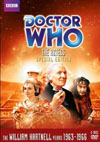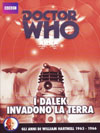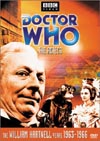Original DVD Extras include:
Special Edition DVD Extras add:
The characters become involved in this adventure in a way which is typical for the first season.... their curiosity leads them to venture too far, and early on their escape in the TARDIS is prevented until the end of the story, in this case by an ingenious Aztec one-way door in the tomb. Ooh, but this time it gets far more interesting..... There are times when the Doctor encounters renegade members of his own race, and of other races, who "try to change history", and he usually jumps in heroically throwing everything he has into the fight to try and stop them. This first time the perceived threat to history is from Barbara, whom he has brought with him, and with whom he would like to continue to get along afterwards. And so he must meet the challenge with words, philosophy, compassion, and understanding. And he is the better for it in the end. The time travellers and the Aztecs all have their human flaws, and this story is an excellent interactive character study. Barbara's actions cause the Doctor to confront his strict policy of non-intervention at all costs, and his belief that "not one line" of history can be re-written. This belief is causing him to ignore all the help and good he can provide to others throughout his journeys, causing him to want to run back into the TARDIS throughout every adventure. Barbara is (W)right to let her involvement run true to her principles and her heart, but she is mistaken in believing that one figure in authority can forcibly alter the entire views, philosophies, and traditions of an entire culture of people. The Doctor is right to caution her bloated ego, knowing how much extra danger she is placing all four travellers in unnecessarily if she isn't more careful. Whose position is more right? This is the kind of question that makes classic drama, and "The Aztecs" has loads of it. Unfortunately, both Barbara and the Doctor resort to deception in their methods, despite the Doctor's reassurance to Tlotoxl in episode three that he "serves only the truth". Barbara is mistaken for the reincarnation of the god Yetaxa, a powerful position which she soon relishes and plans to use to serve her own noble ends. For his own part, the Doctor allows himself to get romantically involved with an Aztec woman, whom he seems to be purposefully deceiving, although he unknowingly ends up much more involved than he had expected. This is yet another aspect of "The Aztecs" that sets it apart from any other Doctor Who story - it seems to be the ONLY on-screen romantic interest that the Doctor has throughout the original television show's 26 year history! The plot is full of twists and turns, as nearly every character gets a scene in which to interact with every other character, and one interesting possibility after another is explored. The acting is the best that the series has turned out so far. John Ringham as Tlotoxl is probably the finest guest villain of the entire first season, creepy, powerful, devious, and perfectly justified in his own mind (not to mention within the rules of his own society) to hold the values and use the methods that he does. It is Carole Ann Ford's turn to take two weeks holiday during episodes two and three of this story, yet she still makes a strong appearance with one pre-filmed scene of good length in each of those episodes - probably the best holiday disappearance of any main Doctor Who character because the absence is virtually non-existent. Her desperate plea for help from her grandfather holds the greatest danger of being hammed up in her performance, yet she carries the moment off beautifully. Ian is also required to stand still and react emotionally for the cliffhanger of part three, which is his most dangerous task in acting, yet this too is surprisingly well done. John Crockett must know some secret to getting actors to give their best! William Hartnell and Jacqueline Hill are usually in top form for most stories, and they certainly turn out some of their best and most riveting work in this one. The cliffhangers are mostly well done. Episode one's is okay, mostly working because of the numerous revelations about how the plot will thicken for the rest of the story - superimposing credits and titles over Tlotoxl's face makes it all very hard to read, but thankfully the director quickly learned to improve. Episode Two's ending is the best of all, with Ian threatened, and everyone wondering what rabbit Barbara could possibly pull out of her feathery hat to solve it. Tune in next week to find out! Episode three's is another good one - not only is Ian threatened, but the Doctor is shown to be powerless to help without betraying him as Ixta gloats and snickers. Most of the music is quite dark and atmospheric, yet also in tune with the ancient culture which our time travellers find themselves in. It is largely a very excellent score. The only danger is that perhaps the strangely light-sounding woodwind herald is used too often, and it isn't too appropriate for announcing villains or danger. Ian gets his own minor villain to tangle with in Ixta, and their conflict is built to a dramatically satisfying climactic battle in the end. Ian also beats Jon Pertwee's Doctor and Mr. Spock to the first use of a nerve-pinch on the neck to subdue his enemy, and Autloc's charismatic portrayal of surprise and astonishment milks the moment for all the dramatic juice possible. The climax of their conflict highlights the beautiful and ingenious set-design and John Crockett's mastery of how to make the illusion of a pyramid balcony overlooking an outdoor city work, without sacrificing any tension in the action-filled fight scene. I wish this director had returned to Doctor Who on other occasions! There is no real climactic heroic action to end the main plot with Tlotoxl, but this works since this is partly the point of the story. The Doctor and his invention are instrumental in the climactic escape, after which he and Barbara take plenty of time to philosophize about the events that have unfolded, which is what forms the real conclusion to the story. Many fans see this tale as a vindication of the Doctor's position. But take a closer look. The Doctor virtually admits that Barbara has changed a line of history, doing the good of helping one man. Thanks to her, the Doctor is pushed further on his own learning curve to becoming a more interactive hero (which goes far to save the story from the philosophical wrath I would inflict on it if it was as simplistic as fans often remember it). Barbara also sees the futility of trying to impose her values on others and change the whole way of life for an entire society, and regrets her use of deception to those ends. An emotionally and philosophically satisfying ending. The Doctor's good-bye to the tomb is also very moody - a pity we can't see the wheel in his hand more clearly though. Actually it is only the novelization that says this is the wheel; on closer examination it appears more to be a gift that Cameca gave the Doctor. I guess it says more about a romantic resolution than any continuation of the Doctor's non-interference time-traveling policy! Although we are once more denied exterior visuals of the TARDIS going and coming, we do get two scenes in the interior and at last the sound effect returns to accompany the Doctor as he operates the controls and dematerializes. A final cliffhanger leaves us exactly where a good cliffhanger should - curious about the answers to a few simple questions, about where the travellers will be in the next episode, and about what they will encounter there.....
International Titles:Deutsch: (Die Azteken)
Original English: "The Aztecs""The Aztecs" is a complete original story available on DVD and VHS video.Click on the Amazon symbol for the location nearest you for pricing and availability:
Comments on this article are welcome. You may contact the author from this page:
|
||||||||||||||||||||||||||||||||||||||||||||||||||












